
The Yale Bowl Stadium is a college football stadium in the northeast United States, located in New Haven, Connecticut, on the border of West Haven, about 1½ miles west of the main campus of Yale University. The home of the American football team of the Yale Bulldogs of the Ivy League, it opened in 1914 with 70,896 seats; renovations have reduced its current capacity to 61,446, still making it the second largest FCS stadium, behind Tennessee State's Nissan Stadium. The Yale Bowl Stadium inspired the design and naming of the Rose Bowl, from which is derived the name of college football's post-season games and the NFL's Super Bowl.

Fred C. Yager Stadium is a football stadium in Oxford, Ohio, United States. It is home to the Miami University RedHawks football team. It has a capacity of 24,286 spectators, and was built in 1983. It replaced Miami Field, which had been used since 1895 and was the home field for many of the coaches who had made the school famous. The stadium is named for Fred C. Yager, class of 1914, who was the lead benefactor in the project to build the stadium.
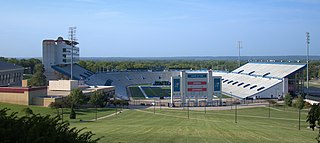
David Booth Kansas Memorial Stadium is a football stadium located in Lawrence, Kansas, on the campus of the University of Kansas. The stadium was opened in 1921, and is the seventh oldest college football stadium in the country, and is widely recognized as the oldest west of the Mississippi River. Nicknamed "The Booth", the stadium is dedicated as a memorial to Kansas students who died in World War I, and is one of seven major veteran's memorials on the campus. The stadium is at the center of all seven war memorials - adjacent to the stadium, further up the hill is a Korean War memorial honoring Kansas students who served, just a few hundred feet south of the stadium stands the University of Kansas World War II Memorial, the Kansas Memorial Campanile and Carillon, the University of Kansas Vietnam War Memorial sits adjacent to the Campanile to the west, the Victory Eagle - World War I statue located on Jayhawk Boulevard, southeast of the stadium, and the Kansas Memorial Union, a veteran's memorial that also houses the main university student union and bookstore, located east of the stadium. The stadium is the home stadium of the Kansas Jayhawks football team.

Kelly/Shorts Stadium is an American football stadium in Mount Pleasant, Michigan. It serves as the home field for the Central Michigan University Chippewas. The stadium opened in 1972 and holds 30,255 spectators, making it the largest on-campus stadium in the Mid-American Conference. It is located on the southeast part of campus, along with most of the other athletic facilities.

Aggie Memorial Stadium is an outdoor football stadium in the southwestern United States, located on the campus of New Mexico State University in Las Cruces, New Mexico. It is the home field of the FBS independent New Mexico State Aggies.

The Glass Bowl is a stadium in Toledo, Ohio. It is primarily used for American football, and is the home field of the American football team of the University of Toledo Rockets. It is located on the school's Bancroft campus, just south of the banks of the Ottawa River. Known for its blend of old and new, it retains the traditional stonework around the field throughout all its expansions.
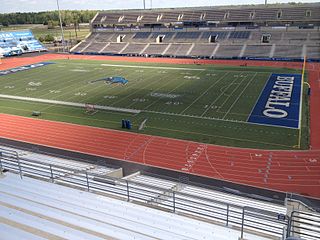
UB Stadium is a stadium in Amherst, New York on the campus of the University at Buffalo. It is primarily used for football, soccer, and track and field events, and is the home field of the Buffalo Bulls. It opened on September 4, 1993, with a game against the University of Maine.
Plaster Stadium is a 17,500-seat football stadium located in Springfield, Missouri. It is home to the Missouri State Bears football team.

Arthur L. Williams Stadium is a 25,000-seat football stadium located on the campus of Liberty University in Lynchburg, Virginia, USA. The stadium was built in 1989 and plays host to Liberty Flames football, which is a part of the NCAA Division I - Football Bowl Subdivision (FBS). A new field house has recently been constructed at the north end of the stadium. This new facility houses a new home locker room, coaches offices, meeting rooms and training facility as well as a 16,000-square-foot (1,500 m2) weight room. In the 2009 off season, Liberty University added a video scoreboard on the north end of the field. The video scoreboard measured 20 feet (6 m) tall and 36 feet (11 m) wide. This video board was replaced by a massive new high-definition video board in time for the 2018 football season.

W. Max Finley Stadium is the home stadium for the University of Tennessee at Chattanooga football team and Chattanooga FC (NISA), a professional Division 3 soccer team. The stadium also hosts various high school sports and musical concerts. It is located in Chattanooga, Tennessee, United States. The stadium, which opened in 1997, has a current capacity of 20,412, and hosted the NCAA Division I National Championship Game from its opening season through 2009, after which the game moved to Pizza Hut Park in the Dallas suburb of Frisco, Texas. The stadium will host the TSSAA Football Championships in 2021 and 2022.
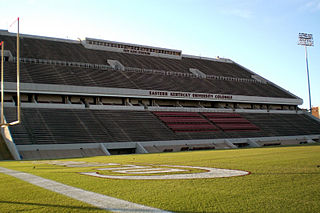
CG Bank Field at Roy Kidd Stadium is Eastern Kentucky University's football stadium in Richmond, Kentucky. The stadium is home to the EKU Colonels football team, located on campus. Currently, CG Bank Field at Roy Kidd Stadium consists of upper and lower-level seating areas with a predominant majority of the seats being metal bleachers. Reserved chairback seats can be found in the middle of the lower level, as well, the seats are generally purchased by season ticket holders and Eastern Alumni.
Bob Waters Field at E. J. Whitmire Stadium is a 13,742-seat football stadium in Cullowhee, North Carolina. It opened in 1974 and is home to the Western Carolina University Catamounts football team. The field itself is named Bob Waters Field. The football facility is located on the south end of the WCU campus and is bordered by Cullowhee Creek on the west side; Jordan-Phillips Field House and WCU Weight Room on its north end, and the Liston B. Ramsey Regional Activity Center on the south end.

Gibbs Stadium is a 13,000-seat multi-purpose stadium in Spartanburg, South Carolina. It opened in 1996 and is home to the Wofford College Terriers football team. It is also the home to the Spartanburg High School varsity football team. It is home to the 30th largest college football scoreboard in the nation at 1,485 square feet (138.0 m2). It was named for the Gibbs family, long-time donors to Wofford, for their $1 million donation to build it.
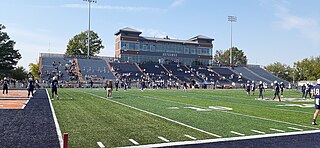
Hardy M. Graham Stadium is a 7,500-seat multi-purpose stadium in Martin, Tennessee. It is home to the University of Tennessee at Martin Skyhawks football team. The facility opened in 1964. It is located north of Tennessee State Route 431 from the central campus area, adjacent to the Agricultural Experiment Station.

Joan C. Edwards Stadium, formerly Marshall University Stadium, is a football stadium located on the campus of Marshall University in Huntington, West Virginia, United States. It can hold 38,227 spectators and includes twenty deluxe, indoor suites, 300 wheelchair-accessible seating, a state-of-the-art press-box, 14 concession areas, and 16 separate restrooms. It also features 90,000 sq ft (8,000 m2) of artificial turf and 1,837 tons of structural steel. It also houses the Shewey Athletic Center, a fieldhouse and a training facility. The new stadium opened in 1991 and replaced Fairfield Stadium, a condemned off-campus facility built in 1927 in the Fairfield Park neighborhood.

Truist Field at Wake Forest is a football stadium in Winston-Salem, North Carolina. The stadium is just west of Gene Hooks Field at Wake Forest Baseball Park, home of the Wake Forest baseball team. It is primarily used for American football, and is the home field of the Wake Forest University Demon Deacons. The stadium opened in 1968 and holds 31,500 people. It is the smallest football stadium, by capacity, in both the ACC and in all Power 5 conferences. Previously known as Groves Stadium, in September 2007, Wake Forest University and BB&T, which was headquartered in Winston-Salem, announced a 10-year deal to officially rename the stadium BB&T Field starting with the first 2007 home game against Nebraska. The deal was part of a larger development process to secure funds for stadium renovations and upgrades. On July 8, 2020, the name of the stadium was changed to Truist Field at Wake Forest following a merger between BB&T and SunTrust.
Sea Foam Stadium is the football field on the campus of Concordia University, Saint Paul in Saint Paul, Minnesota. It opened in 2009, and seats about 3,500 spectators. The Stadium includes a football/soccer field with artificial turf, running track, scoreboard, lights, bleachers, parking, concession facilities, locker rooms, weight room, press box, outdoor plaza, and inflatable dome, somewhat resembling a marshmallow, during the winter months.

Morse Field at Harold Alfond Sports Stadium is a 10,000-seat multi-purpose stadium in Orono, Maine. The stadium opened as Alumni Field in 1947 and underwent extensive renovations from 1996 to 1998. It is home to the University of Maine Black Bears football team. The wood and steel grandstands, built in the 1940s, were condemned and demolished in 1996, replaced with the current east grandstand, along with a temporary structure on the west side, adjacent to Alfond Arena. The current west grandstand, lights, press and luxury levels, as well as concessions and restroom amenities were completed prior to the 1998 season. The stadium was rededicated to Harold Alfond, a longtime Maine booster, at Maine's first home night game on September 12, 1998, a 52–28 win over New Hampshire in the Battle for the Brice-Cowell Musket. The field is named for Phillip and Susan Morse, who donated the lights, original Astroturf and scoreboard. In the summer of 2008, new FieldTurf was installed to replace the old AstroTurf. In 2014, a 20-by-32-foot HD video-board replaced the matrix display installed in 1998, and a contemporary scoreboard was installed on the north end.
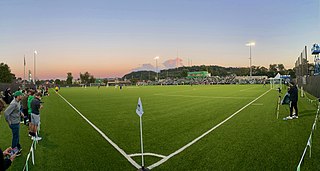
Hoops Family Field at Veterans Memorial Soccer Complex is a 1,006-capacity soccer-specific stadium in Huntington, West Virginia where it is the home of Marshall University's men's and women's soccer teams. It was built on the former site of the Veterans Memorial Fieldhouse, which was demolished in order to build the stadium. An inaugural double-header took place on August 23, 2013. The men's team held a scrimmage against Marshall alumni from past years resulting in a 2–0 victory. The women's team faced the Campbell University Fighting Camels and won 3–0.
Kingston Stadium is a football stadium in Cedar Rapids, Iowa. Kingston Stadium is located southwest of downtown Cedar Rapids, adjacent to Veterans Memorial Stadium and ImOn Ice Arena. Opened September 12, 1952, it was named for a settlement called Kingston established in 1839 on the west side of the Cedar River which was later annexed into Cedar Rapids.


















